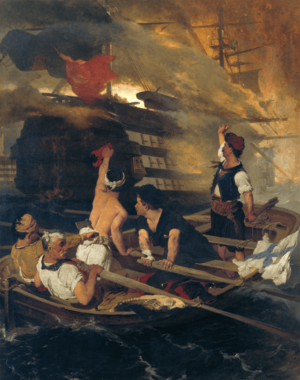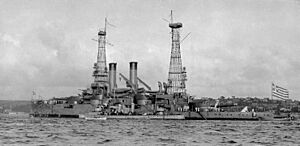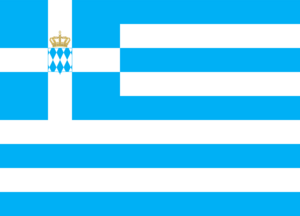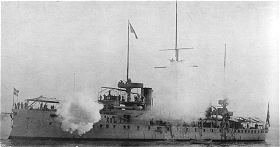History of the Hellenic Navy facts for kids
The Hellenic Navy (Greek: Πολεμικό Ναυτικό) has a long and exciting history! It started when modern Greece became an independent country. Because Greece has so many islands and a long coastline, its navy has always been super important for protecting the country. It's like the main protector of Greece's seas.
Contents
At the start of the Greek War of Independence, Greece didn't have a formal navy. Instead, its naval power came from the merchant ships of islanders from Hydra, Spetsai, Poros, Psara, and Samos. These ships were very important for the success of the revolt. Their main job was to stop the Ottoman Navy from sending supplies and soldiers to Ottoman strongholds in Greece.

Greek sailors were very skilled, but their light merchant ships couldn't fight big Turkish warships head-on. So, the Greeks used a clever tactic: fireships (Greek: πυρπολικά). These were old ships filled with explosives and set on fire, then steered into enemy ships. Brave sailors like Konstantinos Kanaris became famous for using fireships. Under leaders like Andreas Miaoulis, the Greek fleet won early battles. This helped the revolt survive on the mainland.
However, Greece soon faced a civil war. The Sultan asked Muhammad Ali of Egypt for help. Because of internal problems and money troubles, the Greeks couldn't stop the capture of Kasos and Psara in 1824. They also couldn't prevent the Egyptian army from landing at Modon. The revolution was in danger until other powerful countries stepped in. In 1827, the combined fleets of Britain, France, and the Russian Empire completely defeated the Egypto-Ottoman fleet at the Battle of Navarino. This battle truly secured Greece's independence.
When Ioannis Capodistrias became the first governor of free Greece, the navy had only a few ships left. Konstantinos Kanaris became the first minister for naval affairs. The strongest ship was the frigate Hellas, built in the United States in 1825. The navy set up its main base on Poros island. New ships were built, and old ones were retired. Efforts also began to properly train naval officers. Young men first trained at the military school before joining the navy.
In 1831, Greece faced more unrest. Areas like Mani Peninsula and Hydra revolted. During this time, Admiral Andreas Miaoulis sadly set fire to the flagship Hellas while it was docked at Poros. Governor Capodistrias was assassinated a few months later.
When the new King Otto arrived in Nafplion in 1832, the Greek fleet was quite small. It had one corvette, three brigs, six gollettes, two gunboats, two steamboats, and a few smaller vessels. The first Naval School opened in 1846 on the corvette Loudovikos. Leonidas Palaskas was its first director. However, officer training was not very good. There were also disagreements between those who wanted new technology and those who preferred old traditions. This made the navy small and not very effective. Its main job was to patrol the seas and chase pirates.
In the 1850s, those who wanted to modernize the navy gained more influence. The fleet grew with new ships. In 1855, Greece ordered its first iron, propeller-driven steamships from England. These were the Panopi, Pliksavra, Afroessa, and Sfendoni.
During the 1866 Cretan revolt, the Royal Hellenic Navy was not strong enough to help. This failure made the government realize the navy needed to be much better. They decided that the navy should be built for war and aim for victory. Because of this, the fleet received new and larger ships. These ships included new technologies like iron shipbuilding and the invention of the torpedo. These changes greatly improved the Hellenic Navy's power and look.
After 1878, following the Russo-Turkish War, Greece needed to expand its navy. A new, larger naval base was built near Faneromeni on Salamis. A few years later, it moved to Arapis, where it is today. At the same time, the Naval Academy was founded, with Ilias Kanellopoulos as its director. In 1884, a French naval mission arrived. Led by Admiral Laurent Joseph Lejeune, they introduced new ways of organizing the navy and training sailors.
During the government of Charilaos Trikoupis in 1889, the fleet grew even more. Greece bought new battleships from France: Hydra, Spetsai, and Psara. So, when Greece fought in the Greco-Turkish War in 1897, the Hellenic Navy controlled the Aegean Sea. However, its success at sea could not change the outcome of the war on land, which was a national defeat.
In 1907, the Hellenic Navy General Staff (Γενικό Επιτελείο Ναυτικού) was created. Captain Pavlos Kountouriotis was its first head. After the 1897 war, the Ottoman Empire started building up its own navy. In response, Greece bought the cruiser Georgios Averof from Italy in 1909. In 1910, a British naval mission arrived. Led by Admiral Lionel Grant Tufnell, they helped improve the navy's organization and training, especially in strategy.
World War I and Beyond: 1914–1940
Just before the Balkan Wars, the Greek Navy had a fleet of destroyers and battleships. Its main goal was to attack and capture Ottoman-held islands in the Eastern Aegean Sea. It also aimed to control the seas in that area. To do this, its commander, Rear Admiral Pavlos Kountouriotis, set up a forward base at Moudros Bay on Lemnos island. This base was directly across from the Dardanelles straits. After defeating two Turkish attacks from the Straits at Elli (December 1912) and Lemnos (January 1913), Greece secured the Aegean Sea.

After the Balkan Wars, tensions grew between Greece and the Ottoman Empire over the status of the Eastern Aegean islands. Both countries started buying more warships. Greece bought the older battleships Lemnos and Kilkis, and the light cruiser Elli. It also ordered two huge new battleships called dreadnoughts, Vasilefs Konstantinos and Salamis, plus several destroyers. However, when World War I began, the building of the dreadnoughts stopped.
At first, Greece stayed neutral in World War I. Prime Minister Eleftherios Venizelos supported the Allies, while pro-German King Constantine I wanted to remain neutral. This disagreement caused a big political conflict called the "National Schism". In November 1916, to pressure the king's government, the French took control of Greek ships. These ships operated with French crews, mainly escorting convoys and patrolling the Aegean. When Greece joined the Allies in July 1917, the ships were returned. The Greek Navy then helped in Allied operations in the Aegean, supported Denikin's White Armies in the Ukraine, and took part in the Greco-Turkish War of 1919–1922 in Asia Minor.
After Greece's big defeat in that war, the 1920s and early 1930s were difficult times. The economy was bad, so the Navy didn't get many new ships. Four destroyers were modernized, and Greece bought six French submarines in 1927 and four Italian destroyers in 1929.
World War II
In 1938, Greece ordered four modern Greyhound-class destroyers from English shipyards. This was a big step towards modernizing the navy. However, when war broke out in Europe, only two of these destroyers were delivered. When Greece entered World War II, its navy was not very strong. It had ten destroyers, two old battleships, two light cruisers, and six submarines. In 1940, just before the Italian invasion, the Royal Hellenic Navy had 34 ships and 6,500 sailors.
The Hellenic Navy suffered its first loss on August 15, 1940, before the war officially began for Greece. The cruiser Elli was sunk by an Italian submarine. During the Greco-Italian War, the Navy escorted convoys in the Aegean and Ionian Sea. It also tried three times to attack Italian supply convoys in the Strait of Otranto, but without success. Submarines played an important role. Even though they were old, they sank some Italian cargo ships in the Adriatic Sea. However, the Greek submarine force was too small to seriously stop supplies between Italy and Albania.
When Nazi Germany attacked Greece in April 1941, the Royal Hellenic Navy was heavily damaged by the Luftwaffe (German air force). It lost 25 ships in just a few days. It was then decided to move the remaining fleet to Alexandria in Egypt. This fleet included the famous cruiser Georgios Averof, six destroyers, five submarines, three torpedo boats, and other support vessels. In Alexandria, the ships were repaired and given modern anti-aircraft weapons.
For the rest of the war, the Royal Hellenic Navy fought alongside the Allies from bases in the Middle East. As the war continued, the number of Greek ships grew. The British Royal Navy gave Greece several destroyers and submarines. By early 1944, the Greek Navy had 44 ships and 8,500 sailors.
Some important moments for the Royal Hellenic Navy in World War II include the operations of the destroyer Vasilissa Olga. Until it was sunk at Leros on September 23, 1943, it was the most successful Allied destroyer in the Mediterranean Sea. Two Greek destroyers also took part in Operation Overlord (the D-Day landings). Another amazing story is that of the destroyer Adrias. In October 1943, near Kalymnos, it hit a mine. The front part of the ship was blown off, but Adrias managed to sail 400 miles back to Alexandria, even without its bow! Six Greek warships also helped with the landings in Sicily and the later Italian campaign.
In April 1944, some sailors on five Greek warships in Alexandria started a mutiny due to political reasons. This spread to other Greek naval and merchant ships. The Greek Navy at that time didn't have Naval Infantry. So, a special group of sailors, officers, and even army officers put down the mutiny.
Modern Era: 1950s–1990s
After World War II, the Royal Hellenic Navy became much stronger. It received ships from Britain and Italy. Its organization also changed to fit modern naval ideas, especially after Greece joined NATO in 1952. In the early 1950s, military aid from the United States became very important. The Royal Hellenic Navy received its first Cannon-class destroyers, which were nicknamed Beasts (Θηρία). The older British ships were then retired.
Another big change happened in the early 1970s. Greece was the first Mediterranean country to order missile-equipped fast attack craft (La Combattante II) and Type 209 submarines. US military aid continued with FRAM II type destroyers. In 1979, the Hellenic Navy ordered two modern Standard-class frigates (the Elli class) from the Netherlands. These were the first new main surface warships Greece had bought in almost 40 years, rather than using second-hand ships.
The Hellenic Navy grew a lot during the 1990s. New Hydra class (MEKO 200 HN) frigates arrived, along with more Standard-class frigates. Greece also ordered more missile corvettes, Poseidon-class (Type 209) submarines, and naval helicopters. This allowed older ships to be retired. At the same time, Greece was the first Mediterranean country to receive guided missile destroyers. Four Charles F. Adams-class destroyers were transferred from the US Navy in 1992. However, all four have since been taken out of service because their electronics and missiles were not modern enough for today's battles.
The navy continued to advance by ordering Type 214 submarines, which have a special system that lets them stay underwater longer without needing to surface for air. They also acquired Sikorsky S-70B-6/10 Aegean Hawk helicopters and Zubr-class hovercraft from Russia.
Future plans for the Hellenic Navy include updating the Standard-class frigates with new electronics and radar systems. They also plan to modernize the Glaukos and Poseidon-class submarines with new sonars, electronics, and air-independent propulsion engines. Greece is also talking with the US Navy about possibly getting two Arleigh Burke-class destroyers.
See also
- Byzantine navy



